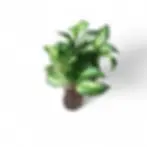Dischidia nummularia – the Button String Epiphyte
Family: Apocynaceae (subfamily Asclepiadoideae)
Dischidia nummularia R.Br. (published in Prodromus Florae Novae Hollandiae, 1810) is a compact trailing epiphyte native to tropical Asia and northern Australia. Commonly known as the Button Dischidia or String of Nickels, it forms soft cascades of tiny, rounded leaves that resemble strings of coins. Closely related to Hoyas, this miniature climber thrives in bright, humid spaces and brings gentle texture to hanging planters, kokedamas, or terrariums.● Botanical identity and natural habitat
- Accepted name: Dischidia nummularia R.Br.
- Published in: R. Brown, Prodr. Fl. Nov. Holland., p. 461 (1810)
- Native range: India, Sri Lanka, Thailand, Malaysia, Indonesia, Papua New Guinea, and northern Australia
- Habitat: Epiphytic on tree trunks and branches in humid tropical forests under bright filtered light
- Growth style: Forms creeping mats and pendulous strands that root along nodes
● Morphology and appearance
- Growth form: Evergreen trailing vine with fine wiry stems, often cascading or creeping.
- Leaves: Opposite, round to oval, 6–12 mm wide, fleshy and slightly convex.
- Color: Light to mid-green; can take on silvery tones in strong light.
- Flowers: Tiny white to cream star-shaped blooms, sometimes lightly fragrant, appearing at stem nodes in warm, humid periods.
- Fruit: Slender paired pods typical of milkweed relatives, dispersing silky-haired seeds by air.
- Habit: Naturally cascading; perfect for hanging pots, bark mounts, or terrarium walls.
● Indoor care and growing conditions
- Light: Bright, indirect light keeps foliage compact and color rich; avoid harsh midday sun.
- Temperature: 18–30 °C ideal; growth slows below 15 °C.
- Humidity: 60–85 % preferred; excellent in terrariums or near humidifiers.
- Watering: Allow the substrate to dry slightly between waterings; avoid stagnant moisture.
- Substrate: Use a loose epiphytic mix — bark, perlite, coco chips, and sphagnum — for air and drainage.
- Feeding: Fertilize lightly once a month with a balanced, diluted solution during active growth.
- Air movement: Gentle airflow prevents fungal issues and promotes root health.
- Mounting: Grows well mounted on cork or driftwood, or trailing from hanging baskets.
● Common issues and solutions
- Shriveled leaves: Caused by underwatering or low humidity — increase misting or humidity level.
- Yellowing or soft foliage: Indicates overwatering or compact substrate — refresh mix and reduce watering.
- No flowering: Usually from low light or excessive nitrogen; increase brightness and reduce feed strength.
- Pests: Watch for mealybugs and scale; remove manually and treat with mild insecticidal soap.
- Root rot: Prevent by maintaining aeration and never allowing the roots to sit in water.
● Collector appeal
Dischidia nummularia combines minimalism with intricate growth detail. Its cascading strands bring movement to still spaces, while its coin-shaped leaves add rhythm and symmetry. Favored by collectors of Hoyas and miniature orchids, this species adapts well to modern interiors, vertical gardens, and humid terrariums alike.
● Toxicity
Contains a mild latex typical of the milkweed family. Mildly irritating to skin or mouth if chewed; best kept away from pets and children.
● Etymology
The genus name Dischidia derives from Greek dis (“twice”) and schidion (“split”), referring to the plant’s twin seed pods. The epithet nummularia means “coin-shaped,” describing its round leaves.
● FAQs – Dischidia nummularia
- What type of plant is it? A small, trailing epiphyte related to Hoyas, forming dense hanging strings of rounded leaves.
- Where does it grow naturally? Across tropical Asia to northern Australia, on bark and branches in humid forests.
- How much light does it need? Bright indirect light; a few hours of gentle morning sun are beneficial.
- How often should I water it? Water when the mix feels dry on top; it dislikes staying constantly wet.
- Does it need high humidity? Yes — around 60–80 % keeps leaves firm and healthy.
- Why isn’t it flowering? Likely due to low light or overfeeding; increase brightness and reduce fertilizer.
- Can it grow mounted without soil? Absolutely — it naturally grows epiphytically and adapts well to bark or cork.
- Is it toxic to pets? Mildly; its latex can irritate mouths or skin, so place out of reach.
- Why are my leaves turning yellow? Usually from overwatering or poor airflow; refresh mix and reduce frequency.
- How to make it fuller? Prune lightly above nodes; new shoots branch from cut points.
● Buy Dischidia nummularia now
Bring home Dischidia nummularia — a refined tropical epiphyte that drapes gracefully and thrives on bright light, gentle moisture, and steady humidity. Perfect for collectors of Hoyas, orchids, and rare aerial plants.
Dischidia nummularia
Black Week - 25% Off Everything
Dischidia nummularia is approximately 25 cm long, comes in a ⌀ 14 cm hanging pot.






























